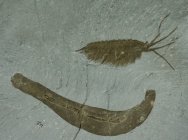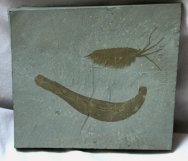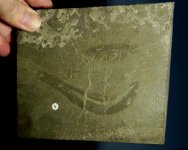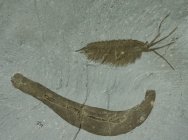Leanchoilia
superlata
Phylum
Arthropoda, Order Leanchoilidae
Ottoia prolifica
Phylum Priapulida, Family Ottoidae
Geological
Time: Early Cambrian, (~520 million years ago)
Size (25.4
mm = 1 inch): Leanchoilia: 50 mm overall, plus 22-27 mm appendages;
Ottoia: 112 mm (measured along center line) on a 145 mm by 125 mm matrix
Fossil Site:
Stephen Formation, Burgess Shale, Burgess Pass, British Columbia, Canada
Fossil Code:
JH38
Price: $9250.00
- sold
|  Description:
This plaque shows a pair of predatory animals from the Middle
Cambrian Burgess Shale. Leanchoilia superlata is an unusual arthropod,
a member of a group of “great appendage arthropods” known
as opabinids after the bizarre Opabinia from the Burgess. It
is possibly also known from Utah and Greenland, and has an older
relative Leanchoilia illecebrosa found in the Chengjiang Biota
of China (see my other offerings).
This Description:
This plaque shows a pair of predatory animals from the Middle
Cambrian Burgess Shale. Leanchoilia superlata is an unusual arthropod,
a member of a group of “great appendage arthropods” known
as opabinids after the bizarre Opabinia from the Burgess. It
is possibly also known from Utah and Greenland, and has an older
relative Leanchoilia illecebrosa found in the Chengjiang Biota
of China (see my other offerings).
This  wonderful example shows incredible detail for a specimen
more than a HALF BILLION years
of age. Notice the upturned “snout,” the sweeping
appendages, body segments, and a hint of the gut trace as well
as the gill filaments of the biramous swimming appendages. Coming
from the famous Burgess Shale Fauna, this is a highly-desirable
member which will make a fine addition to any collection of Cambrian
Explosion fossils. It is also quite rare: for each 1000 Burgess
specimens only 2 are Leanchoilia; even fewer are as complete
as this excellent example. wonderful example shows incredible detail for a specimen
more than a HALF BILLION years
of age. Notice the upturned “snout,” the sweeping
appendages, body segments, and a hint of the gut trace as well
as the gill filaments of the biramous swimming appendages. Coming
from the famous Burgess Shale Fauna, this is a highly-desirable
member which will make a fine addition to any collection of Cambrian
Explosion fossils. It is also quite rare: for each 1000 Burgess
specimens only 2 are Leanchoilia; even fewer are as complete
as this excellent example.
The
second specimen is a member of the Burgess Shale priapulid fauna
known as Ottoia prolofica.
It is divided into an anterior proboscis and a posterior trunk
region. The proboscis is seen here everted, with the scalids
(hook-like spines) which it presumably used to capture prey
showing. It is known to be a carnivore as  examples
have been found with several members of the hyolithid Haplophrentis
found in the gut.
It is sometimes found in a U-shaped orientation, presumably
in its life pose (see artist’s rendering). It is not believed
to be closely related to any other priapulid, and thus has been
assigned to its own family, the Ottoidae. The contrast between
the specimens and the matrix has been enhanced by a chemical
process that removed some of the matrix overburden. I have included
a “before” photo so you can see the difference such
treatment makes. Since the specimen is typically covered with
resistant mica and is composed of the carbonized remains of the
animal, it is inert to the treatment. The result you see here
is ALL NATURAL. There has been NO PAINT added to bring out detail.
An example such as this showing both specimens in association
is a rare one indeed. This one would form the centerpiece of
any collection, institutional or private Since the location is
now a World Heritage site only specimens from old collections
such as this are available. examples
have been found with several members of the hyolithid Haplophrentis
found in the gut.
It is sometimes found in a U-shaped orientation, presumably
in its life pose (see artist’s rendering). It is not believed
to be closely related to any other priapulid, and thus has been
assigned to its own family, the Ottoidae. The contrast between
the specimens and the matrix has been enhanced by a chemical
process that removed some of the matrix overburden. I have included
a “before” photo so you can see the difference such
treatment makes. Since the specimen is typically covered with
resistant mica and is composed of the carbonized remains of the
animal, it is inert to the treatment. The result you see here
is ALL NATURAL. There has been NO PAINT added to bring out detail.
An example such as this showing both specimens in association
is a rare one indeed. This one would form the centerpiece of
any collection, institutional or private Since the location is
now a World Heritage site only specimens from old collections
such as this are available.
|
|










